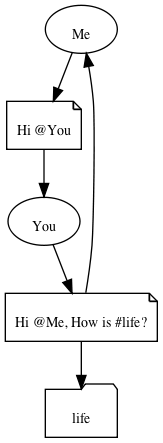 Back in 2009 I made a hackish Python script that would generate a graph like the one shown here from your Twitter account.
It turned out few people are willing to fumble with Python scripts to get 'just an image'. Luckily, I'm releasing a completely rewritten web app for the same cool idea!
tweetograph.pepijn.cqhosting.nl
Now with support for oauth, mentions, retweets, replies, gif, svg, dot, and a lot more.
It is written with Python and web.py, using this script from my previous post.
Back in 2009 I made a hackish Python script that would generate a graph like the one shown here from your Twitter account.
It turned out few people are willing to fumble with Python scripts to get 'just an image'. Luckily, I'm releasing a completely rewritten web app for the same cool idea!
tweetograph.pepijn.cqhosting.nl
Now with support for oauth, mentions, retweets, replies, gif, svg, dot, and a lot more.
It is written with Python and web.py, using this script from my previous post.
Tweet-o-Graph
 Back in 2009 I made a hackish Python script that would generate a graph like the one shown here from your Twitter account.
It turned out few people are willing to fumble with Python scripts to get 'just an image'. Luckily, I'm releasing a completely rewritten web app for the same cool idea!
tweetograph.pepijn.cqhosting.nl
Now with support for oauth, mentions, retweets, replies, gif, svg, dot, and a lot more.
It is written with Python and web.py, using this script from my previous post.
Back in 2009 I made a hackish Python script that would generate a graph like the one shown here from your Twitter account.
It turned out few people are willing to fumble with Python scripts to get 'just an image'. Luckily, I'm releasing a completely rewritten web app for the same cool idea!
tweetograph.pepijn.cqhosting.nl
Now with support for oauth, mentions, retweets, replies, gif, svg, dot, and a lot more.
It is written with Python and web.py, using this script from my previous post.
